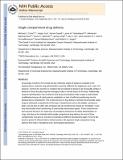| dc.contributor.author | Cima, Michael J. | |
| dc.contributor.author | Daniel, Karen | |
| dc.contributor.author | Mantzavinou, Aikaterini | |
| dc.contributor.author | Ong, Qunya | |
| dc.contributor.author | Sy, Jay C. | |
| dc.contributor.author | Santini, John | |
| dc.contributor.author | Blankschtein, Daniel | |
| dc.contributor.author | Tanenbaum, Laura Melanie | |
| dc.contributor.author | Lee, Heejin, 1976- | |
| dc.contributor.author | Spencer, Kevin C | |
| dc.contributor.author | Schoellhammer, Carl Magnus | |
| dc.contributor.author | Langer, Robert S | |
| dc.date.accessioned | 2016-02-09T20:13:13Z | |
| dc.date.available | 2016-02-09T20:13:13Z | |
| dc.date.issued | 2014-05 | |
| dc.date.submitted | 2014-02 | |
| dc.identifier.issn | 01683659 | |
| dc.identifier.uri | http://hdl.handle.net/1721.1/101146 | |
| dc.description.abstract | Drug design is built on the concept that key molecular targets of disease are isolated in the diseased tissue. Systemic drug administration would be sufficient for targeting in such a case. It is, however, common for enzymes or receptors that are integral to disease to be structurally similar or identical to those that play important biological roles in normal tissues of the body. Additionally, systemic administration may not lead to local drug concentrations high enough to yield disease modification because of rapid systemic metabolism or lack of sufficient partitioning into the diseased tissue compartment. This review focuses on drug delivery methods that physically target drugs to individual compartments of the body. Compartments such as the bladder, peritoneum, brain, eye and skin are often sites of disease and can sometimes be viewed as “privileged,” since they intrinsically hinder partitioning of systemically administered agents. These compartments have become the focus of a wide array of procedures and devices for direct administration of drugs. We discuss the rationale behind single compartment drug delivery for each of these compartments, and give an overview of examples at different development stages, from the lab bench to phase III clinical trials to clinical practice. We approach single compartment drug delivery from both a translational and a technological perspective. | en_US |
| dc.description.sponsorship | National Institutes of Health (U.S.) (Grant R37EB000244) | en_US |
| dc.description.sponsorship | National Institutes of Health (U.S.) (Grant K99EB016690) | en_US |
| dc.description.sponsorship | National Institutes of Health (U.S.) (Grant R01EB016101) | en_US |
| dc.description.sponsorship | Massachusetts Institute of Technology. Institute for Soldier Nanotechnologies (Grant W911NF-13-D-0001) | en_US |
| dc.description.sponsorship | Singapore. Agency for Science, Technology and Research | en_US |
| dc.description.sponsorship | National Science Foundation (U.S.). Graduate Research Fellowship | en_US |
| dc.description.sponsorship | David H. Koch Institute for Integrative Cancer Research at MIT (Bridge Project) | en_US |
| dc.description.sponsorship | David H. Koch Institute for Integrative Cancer Research at MIT (Core Grant) | en_US |
| dc.language.iso | en_US | |
| dc.publisher | Elsevier | en_US |
| dc.relation.isversionof | http://dx.doi.org/10.1016/j.jconrel.2014.04.049 | en_US |
| dc.rights | Creative Commons Attribution-NonCommercial-NoDerivs License | en_US |
| dc.rights.uri | http://creativecommons.org/licenses/by-nc-nd/4.0/ | en_US |
| dc.source | PMC | en_US |
| dc.title | Single compartment drug delivery | en_US |
| dc.type | Article | en_US |
| dc.identifier.citation | Cima, Michael J., Heejin Lee, Karen Daniel, Laura M. Tanenbaum, Aikaterini Mantzavinou, Kevin C. Spencer, Qunya Ong, et al. “Single Compartment Drug Delivery.” Journal of Controlled Release 190 (September 2014): 157–71. | en_US |
| dc.contributor.department | Harvard University--MIT Division of Health Sciences and Technology | en_US |
| dc.contributor.department | Massachusetts Institute of Technology. Department of Chemical Engineering | en_US |
| dc.contributor.department | Massachusetts Institute of Technology. Department of Materials Science and Engineering | en_US |
| dc.contributor.department | Koch Institute for Integrative Cancer Research at MIT | en_US |
| dc.contributor.mitauthor | Cima, Michael J. | en_US |
| dc.contributor.mitauthor | Tanenbaum, Laura Melanie | en_US |
| dc.contributor.mitauthor | Mantzavinou, Aikaterini | en_US |
| dc.contributor.mitauthor | Spencer, Kevin C. | en_US |
| dc.contributor.mitauthor | Ong, Qunya | en_US |
| dc.contributor.mitauthor | Sy, Jay C. | en_US |
| dc.contributor.mitauthor | Schoellhammer, Carl | en_US |
| dc.contributor.mitauthor | Blankschtein, Daniel | en_US |
| dc.contributor.mitauthor | Langer, Robert | en_US |
| dc.relation.journal | Journal of Controlled Release | en_US |
| dc.eprint.version | Author's final manuscript | en_US |
| dc.type.uri | http://purl.org/eprint/type/JournalArticle | en_US |
| eprint.status | http://purl.org/eprint/status/PeerReviewed | en_US |
| dspace.orderedauthors | Cima, Michael J.; Lee, Heejin; Daniel, Karen; Tanenbaum, Laura M.; Mantzavinou, Aikaterini; Spencer, Kevin C.; Ong, Qunya; Sy, Jay C.; Santini, John; Schoellhammer, Carl M.; Blankschtein, Daniel; Langer, Robert S. | en_US |
| dc.identifier.orcid | https://orcid.org/0000-0003-2379-6139 | |
| dc.identifier.orcid | https://orcid.org/0000-0001-6694-6761 | |
| dc.identifier.orcid | https://orcid.org/0000-0002-7963-8706 | |
| dc.identifier.orcid | https://orcid.org/0000-0001-8586-6900 | |
| dc.identifier.orcid | https://orcid.org/0000-0002-7836-415X | |
| dc.identifier.orcid | https://orcid.org/0000-0003-4255-0492 | |
| mit.license | PUBLISHER_CC | en_US |
